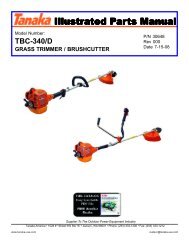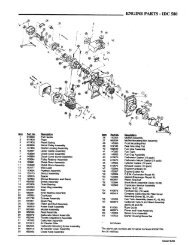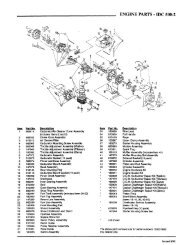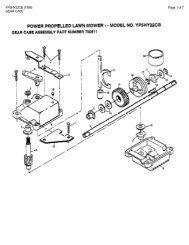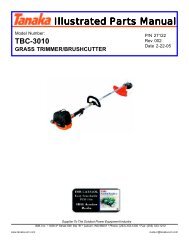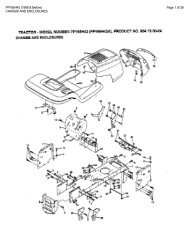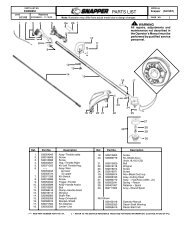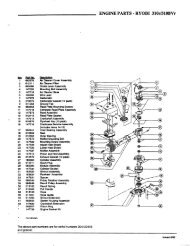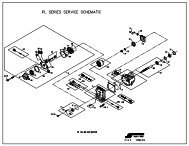Snapper Lawn Tractor Hydrostatic Drive Electric Clutch Series G ...
Snapper Lawn Tractor Hydrostatic Drive Electric Clutch Series G ...
Snapper Lawn Tractor Hydrostatic Drive Electric Clutch Series G ...
Create successful ePaper yourself
Turn your PDF publications into a flip-book with our unique Google optimized e-Paper software.
Section 4 - ADJUSTMENT & REPAIRWARNINGDO NOT OVERFILL! Never attempt to service orcharge the battery while it is installed on the machine.DO NOT use “BOOST” chargers on the battery.4.5.5. BATTERY TESTINGThere are two types of battery tests: Unloaded andLoaded. The unloaded test is the procedure that willbe discussed. It’s the simplest and most commonlyused. An unloaded test is made on a battery withoutdischarging current. To perform unloaded testing,check charge condition using either a hydrometer orvoltmeter.1. Using a voltmeter, voltage readings appearinstantly to show the state of charge. Remember tohook the positive lead to the battery’s positiveterminal, and the negative lead to the negativeterminal.2. A hydrometer measures the specific gravity ofeach cell. The specific gravity tells the degree ofcharge; generally, a specific gravity of about 1.265 to1.280 indicates full charge. A reading of 1.230 to1.260 indicates the battery should be charged. Thechart on the next page shows the charge level asmeasured by syringe float hydrometer, digitalvoltmeter and five ball hydrometer.4.5.6. NEW BATTERY PREPARATION1. Remove battery from carton.2. Place battery in a well ventilated area on a level nonconcretesurface.3. Remove battery cell caps. Fill cells as requiredwith electrolyte (purchased separately) to proper level.Fill to 3/16” above cell plates. Filling battery withelectrolyte will bring the battery to 80% charged state.4. With cell caps removed, connect battery charger tobattery terminals; RED to positive (+) and BLACK tonegative (-) terminal.IMPORTANT: 3/16” above cell plates is the recommendedlevel. DO NOT place anything in battery other than specifiedelectrolyte.5. Slow charge the battery at 1 amp for 2 hours tobring the battery to full charge.6. After charging, check level of electrolyte and addas needed to bring level to 3/16” above cell plates.7. Reinstall cell caps.8. Slide battery partially into battery housing.9. Connect positive (+) cable (red) first, from wiringharness to the positive terminal (+) on battery using boltand nut provided in hardware bag. Connect negative (-)cable (black) last, to negative terminal (-) on batteryusing bolt and nut. Apply a small amount of grease overterminals to prevent corrosion.10. Insert battery completely into battery housing.11. Reinstall seat assembly.WARNINGShield the positive terminal with terminal coverlocated on battery harness. This prevents metal fromtouching the positive terminal, which could causesparks. Cables must be connected to batteryterminals in the proper position. RED (Positive) cablemust go to the ( + ) terminal. BLACK (Negative) cablemust go to the ( - ) terminal.4.5.7. BATTERY TESTINGBattery Condition ChartState of Charge Syringe Hydrometer Digital Voltmeter Five Ball Hydrometer100% Charged w/ Sulfate Stop 1.280 12.80v Five Balls Floating100% Charged 1.265 12.60v Four Balls Floating75% Charged 1.210 12.40v Three Balls Floating50% Charged 1.160 12.10v Two Balls Floating25% Charged 1.120 11.90v One Ball Floating0% Charged Less than 1.100 Less than 11.80v Zero Balls Floating31



